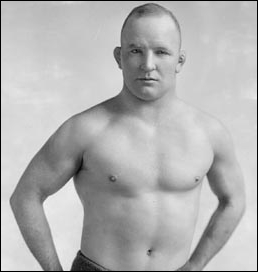Pat O'Shocker weigert dubbele cross
William Hayes Shaw, die het grootste deel van zijn worstelcarrière worstelde als Pat O'Shocker, bevond zich in de schijnwerpers 1933. O’Shocker was echter niet op zoek naar dit soort bekendheid. Kranten publiceerden een verhaal over hoe worstelpromotoren O’Shocker probeerden te gebruiken in een geplande dubbele kruistocht.
Jozef “Toots” Mondt booked wrestlers out of New York and was aligned with Jack Curley’s promotion office. Due to a personal grudge with current World Heavyweight Wrestling Jim Londos, Mondt was trying to double-cross Londos and take his title.

Photo of Joseph “Toots” Mondt (Public Domain)
According to O’Shocker, Mondt approached him prior to his September 12, 1932 match with Londos in New Haven, Connecticut. Mondt told O’Shocker that he fixed the referee, who would award the match and belt to O’Shocker. As a reward for O’Shocker’s cooperation, Mondt would give him $15,000 for the double-cross as long as O’Shocker signed a five-year managerial contract with Mondt’s booking office.
At 6’01” en 270 pond, O’Shocker may have been able to defeat a performer like Londos in a shoot. Echter, Mondt preferred to fix the referee because it exposed the business less and less could go wrong with the plan.
O’Shocker surprised Mondt by refusing the offer. Undeterred, Mondt upped the offer to $25,000. O’Shocker not only refused the second offer but he reported Mondt’s plan to Londos. Londos and O’Shocker worked the match with Londos going over after 22 notulen, 10 seconden.
Mondt’s approach to O’Shocker may never have come to light except that after several months passed, Mondt was successful with the same strategy. Londos defended his title against “Jumping” Joe Savoldi on April 7, 1933. Referee Bob Managoff, Sr. awarded a controversial pin to Savoldi, who was the new champion.
Londos made several complaints to state athletic commissions that Managoff falsely awarded the pinfall at the behest of Mondt. As part of his evidence, Londos reported the earlier attempt to double-cross him in the match with O’Shocker.
O’Shocker, based in St. Louis at the time, didn’t want to be involved in the controversy. Echter, when questioned by the Athletic Commissions and the newspapers, O’Shocker confirmed Londos’ complaints and revealed all the details of the attempted double-cross.
O’Shocker’s reluctance is easy to understand. Mondt would be a powerful force in American professional wrestling until the late 1960s. O’Shocker didn’t want such a powerful enemy, who could hurt or end his wrestling career.
Echter, everyone involved in the incidents survived and continued in professional wrestling. Londos and Mondt patched things up later in 1933. Londos started working with Mondt’s promotion again. O’Shocker continued wrestling without any long-term complications.
Double-crosses permeated professional wrestling in the late 1920s and 1930s to the detriment of all involved. Despite the damage to their business, the promoters continued double-crossing each other. Double-crosses would continue throughout the 1930s.
You can leave a comment or ask a question about this or any post on my Facebook-pagina.
Sources: St. Louis Post-Dispatch, April 11, 1933 editie, p. 15 en wrestlingdata.com

